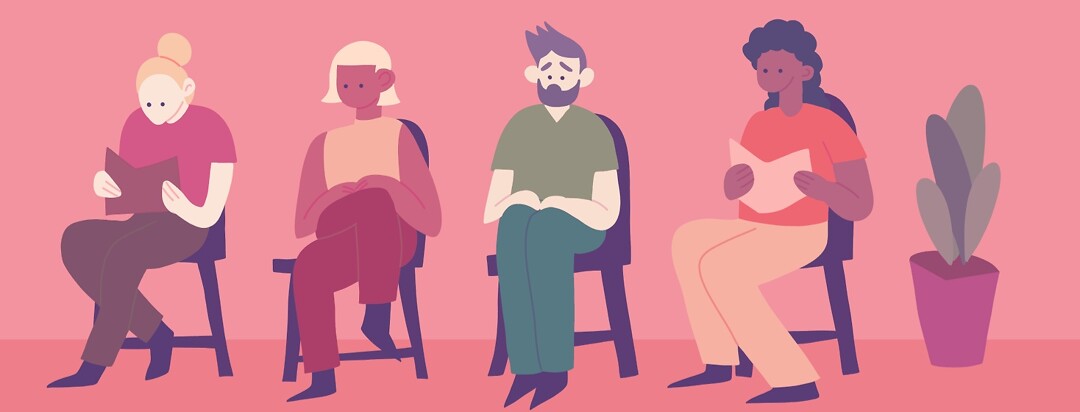Transgender People with Endometriosis Often Suffer in Silence
Before reading this article, you may consider referring to these vocabulary terms:
- Cisgender: The state of identifying your gender with the sex you were assigned at birth
- Transgender: The state of not identifying your gender with the sex you were assigned at birth. For example, a person who is born with a uterus may not identify as being a woman.
- Nonbinary: The state of not identifying your gender as being exclusively male or female, or identifying your gender outside of the gender binary altogether
Because health researchers tend to label menstrual illnesses as "women's diseases," some trans people may not recognize their symptoms as warning signs for endometriosis.
Being diagnosed with endometriosis can make you feel like you're invisible. Historically, doctors have underestimated menstrual pain. But transgender and nonbinary patients often face an additional layer of frustration as they fight for equitable healthcare.
We need better reproductive education
One major obstacle for all menstruating people is the dearth of reproductive education. In middle school, I and my female-identifying friends were shuffled off to a basement classroom where a kind nurse showed us pads, told us how to tie a jacket around our waists to hide leaks, and warned us against having sex. Many sex ed courses, like the one I experienced, do not describe important anatomical details of a period: how the texture and color of your blood can change, how to differentiate between normal cramps or something more serious, and how much bleeding is normal.
Challenges for transgender students
Many children are left to discover these important reproductive realities on their own. I had never heard the word "endometriosis" until I was in my twenties. But transgender students carry an especially heavy burden. Because sex ed courses often divide up male and female students, transgender adolescents fall through the gaps. If a transgender student attends the sex ed course that corresponds with their genitalia, that student may risk outing themselves. They may feel unwelcome in a "girl's class" when they do not identify as a girl. Therefore, some trans students miss out on important lessons about their periods.
Recognizing endometriosis warning signs
Because health researchers tend to label menstrual illnesses as "women's diseases", some trans people may not recognize their symptoms as warning signs for endometriosis. It's difficult to know just how many trans patients suffer in silence with endometriosis. In fact, only a handful of scientific studies have analyzed the topic. But in a 2020 article in Journal of Pediatric and Adolescent Gynecology, researchers found that the majority of trans people with endometriosis are diagnosed after they've transitioned their gender.1 Even after a transgender male patient begins testosterone therapy, he can still have painful symptoms and complications in his uterus.
Delayed diagnosis
Although transgender people can also experience endometriosis, they are less likely than cisgender women to seek diagnosis. Why? Many patients rely on their OB/GYN to perform tests and assess their risk for endometriosis. But most transgender people do not feel safe when visiting a gynecologist. Some reasons why these patients may feel uncomfortable include the following: gendered intake forms, medical discrimination, judgmental doctors, and harassment.
Researchers in Ontario interviewed transgender men in their community to ask about their experiences with gynecological care.2 Of this group, 92% of patients were anxious about visiting a gynecologist. More seriously, 54% had actively avoided getting screenings, pap smears, or other important treatments. Without visiting a gynecologist, transgender people face an uphill battle in getting diagnosed for endometriosis.
How medical professionals can meet the needs of trans patients
Fortunately, medical professionals and health advocates can be better allies. Here are some suggestions for how you can be more inclusive to transgender endometriosis patients:
- Use phrases like "people with endometriosis" or "menstruating people"
- Encourage your local healthcare providers to relabel their "women's services" as "menstrual services"
- Encourage your OB/GYN to include more gender and sex options on their intake paperwork
- Support your local LGBTQ+ health organizations
- Support and follow groups like ThemsHealth, which is a social media platform that highlights trans-friendly health professionals who talk about wellness issues.
Endometriosis isn't just a woman's issue -- it's a human issue. And together, we can push to make menstrual care and education more accessible to every person of every gender.

Join the conversation